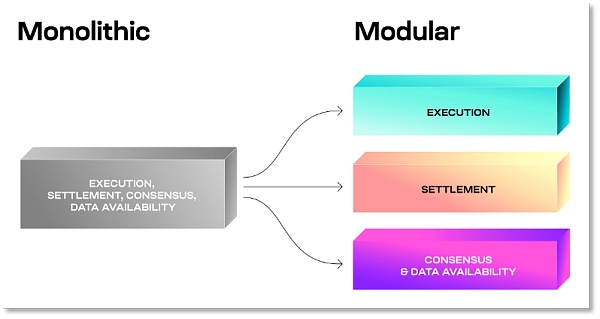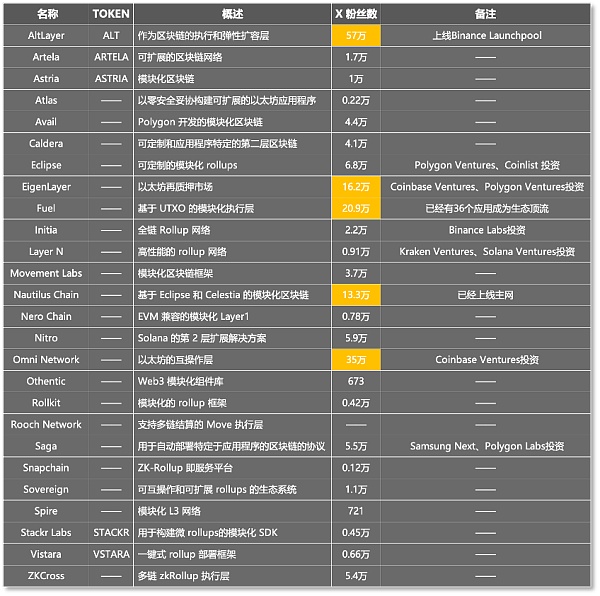The Ethereum Layer 2 network has become an important underlying infrastructure in the Web3 world due to its high efficiency and scalability, while the other group uses modular architecture to provide solutions for scalability. The Layer1/Layer2 network is occupying another corner of the Web3 infrastructure and bursting with vitality.
Modular blockchain aims to completely outsource at least one of the four parts of "execution layer, settlement layer, consensus layer, and data availability layer" to an external chain way to achieve decentralized expansion of the blockchain network without affecting network security.
Since Celestia, the first modular blockchain network, launched its mainnet on October 31 last year, its network’s native Gas token TIA has grown from the initial $2 It rose to around $16 on January 22. With a steady increase of 717% in less than half a year, Celestia’s market value of US$2.5 billion pushed Celestia to 37th place in the crypto asset market value rankings, becoming the only modular blockchain to squeeze into the Top 50, which also allowed capital to see this game. Tao potential.
In 2023, multiple modular blockchain projects received new investment, including Eclipse, AltLayer, Sovereign, Dymension , etc. Today, we will introduce you to the concept and application scenarios of modular blockchain, and sort out high-profile potential projects.
Modular solution to the "Impossible Triangle" problem
If we look at the initial design of the blockchain, both the Bitcoin blockchain and Ethereum are single blockchains, that is, each transaction is used as a carrier, legal and effective transaction records are stored through blocks, and through a specific consensus The mechanism realizes a decentralized, trustless, and tamper-proof distributed ledger network.
A single blockchain can be divided into the following four functional layers:
Consensus: content and order of approved transactions
Execution: Supports the execution of transactions and implements deployment and interaction with smart contracts
Settlement : Used to complete transactions, resolve disputes, verify proofs, and bridge between different execution layers
Data Availability (DA) : Guarantee the availability of transaction data

Modular blockchain solves functional requirements in layers
For a single blockchain, the four functional layers are all on one chain, and the network has to bear all tasks alone. This creates the "impossible triangle" of a monolithic blockchain, that is, scalability, decentralization and security can only satisfy at most two properties on the chain. Most of the current Layer 1 networks sacrifice decentralization features to ensure the security and scalability of the network, while Ethereum insists on decentralization and security, leaving the scalability to Layer 2 that is compatible with the network.
However, with the increase in blockchain transaction volume and the increase in decentralized applications, the frequency of transaction blocking in these individual blockchains is still very high, which makes This leads to an increase in transaction costs, which is not conducive to the operation of the application and also affects the user experience.
In solving the "Impossible Triangle" problem, some developers have proposed a "modular blockchain" solution, which re-creates the problem through aggregation and combination. Layer the blockchain architecture, expand it on demand in a modular manner, and combine the four functional layers with each other to safely improve performance and expand the network without compromising the original tenet of "decentralization." Meet diverse application scenarios.
Modular blockchain can be traced back to the 2018 white paper "Data Availability Sampling and Fraud Proof" co-authored by Mustafa Albasan and Vitalik. This article describes how to solve the blockchain scalability problem without sacrificing security and decentralization by allowing light clients to receive and verify fraud evidence from full nodes and designing a data availability proof system, To reduce on-chain capacity and security trade-offs.
Currently, Rollups and sharding technology are also examples of the transition of the Ethereum ecosystem to modular blockchains.
Rollups extend Ethereum's monolithic architecture by providing a separate layer for execution. Rollups can use powerful computers to package and execute multiple transactions before regularly transmitting compressed data back to the Ethereum mainnet for verification.
Sharding uses Sharding (sharding technology) on the first layer (Layer 1) to achieve capacity expansion. The core idea of the scheme is to split the Ethereum main chain into different shards and randomly rotate validators between these shards. Each shard is essentially its own mini-blockchain and runs in parallel with the beacon chain. Through sharding technology, Ethereum is able to significantly increase transaction throughput and scalability to meet growing user needs.
What are the "potential stocks" of modular blockchain?
Up to now, the Web3 asset data platform RootData has included 36 modular blockchain projects, except Cube and Assembly, which are in a "dead" state In addition, the rest of the modular blockchain networks are under steady construction.

The market value of 5 modular blockchain projects has been tested in the circulation market and ecology.

Celestia is the first modular blockchain network project focused on data availability. Celestia believes that an Ethereum expansion network similar to Layer 2 can publish newly generated data to the Celestia chain instead of directly to Ethereum, thus saving more than 90% of handling fees.
Data Availability Sampling (DAS) is an important feature of Celestia that allows users to confirm the existence of large data blocks without downloading the entire blockchain. This technology greatly improves scalability and security.
In addition, Celestia facilitates the creation of independent, self-managed blockchains, known as sovereign rollups, that benefit from Celestia Security provided by the network.
Blobstream functionality integrates Celestia’s modular data availability layer with Ethereum. This integration enables Ethereum developers to build efficient, high-throughput Layer 2 solutions.
Circulating supply: 159,016,130 TIA
Total supply: 1,017,972,603 TIA
Current price: $15
Historical high: $20.26
Historical low: $2.03
Mantle Network is an L2 extension solution based on Optimistic Rollup technology, which provides EVM compatibility and Modular design. It is incubated by BitDAO and uses roll-up technology and a decentralized data availability layer (Mantle DA) to provide high throughput, low fees and fast deterministic services while ensuring Ethereum-level security.
Circulating supply: 3,162,441,863 MNT
Total supply: 6,219,316,795 MNT
Current price: $0.64
Historical high: $0.8488
Historical low: $0.3136
SKALE Network is a layer 2 scaling solution that uses side On-chain environment to improve the performance of decentralized applications (dApp) on the Ethereum network. SKALE enables developers to run smart contracts at high speed, high throughput and extremely low cost.
SKALE Network is deeply compatible with Ethereum and is not subject to the storage and computing limitations of Ethereum. In addition to supporting thousands of independent blockchains that grow linearly, In addition, it supports various elastic side chains, storage chains and other types of sub-chains.
Circulating supply: 5,134,227,671 SKL
Total supply: 5,447,166,667 SKL
p>
Current price: $0.06
Historical high: $1.22
Historical lowest: $0.01
More modular blockchain economic models and tokens are still in the testing phase, and these projects may be ready to go online The mainnet may begin to attract ecological applications. The following is information about the active modular blockchain network:
 < /p>
< /p>
It is not difficult to find that most of the modular blockchains with high attention have the investment layout of CEX. In addition, some modular blockchains have received mainstream block Attention and even investment in the chain network ecology, some networks have already launched the main network and generated a large number of applications.
For example, AltLayer , which recently landed on Binance Lauchpool, is a highly scalable application-specific execution layer system with Multiple execution layers (called flash layers) similar to optimistic rollup, all transactions get security from the underlying L1/L2, it is designed to be modular and pluggable for the multi-chain and multi-VM world framework, the scalability of the network has been enhanced.
Fuel is the earliest Optimistic Rollup deployed on the Ethereum mainnet. The V1 version was launched at the end of 2020. It is based on the UTXO model The biggest advantage of blockchain is that it can execute transactions in parallel. It provides scalability by using a different execution model from EVM, has a highly parallelizable minimal execution system based on UTXO, supports ETH and all ERC-20 standard tokens, and currently has 36 applications within the ecosystem. Top-notch scenarios include DeFi, DEX, stablecoins, games, NFT, Web3 domain names, etc.
 JinseFinance
JinseFinance




 < /p>
< /p>
